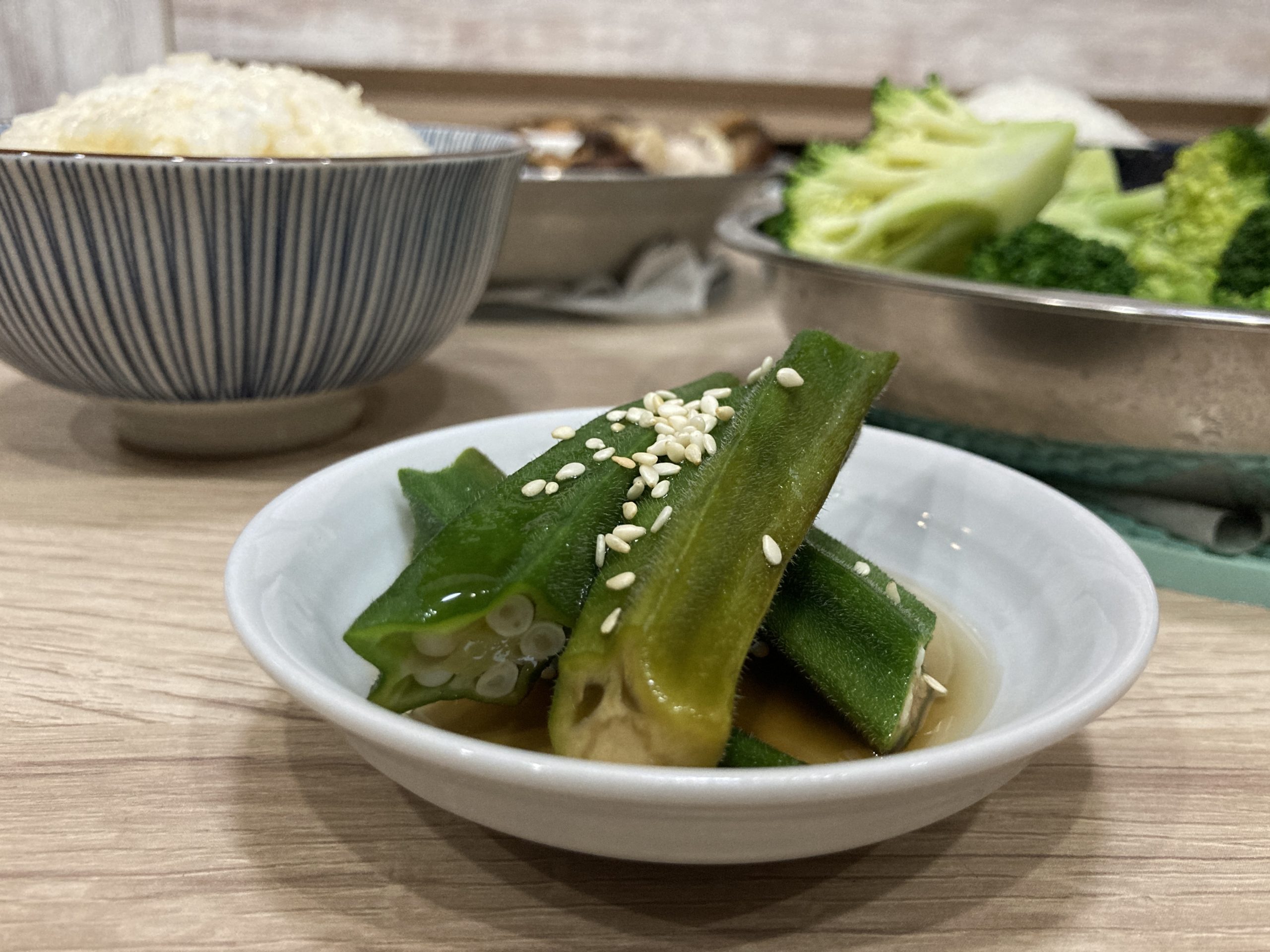A quick and simple side dish. Chilled, blanched okra infused with a dashi-based broth make for a refreshing treat.

Time: 1/5
Quick blanche and a soak – most of the time was spent waiting for water to boil
Effort: 2/5
A bit of knife work followed by pouring stuff into a jar
Cooking Salad
The Japanese hit on a jackpot idea when they invented soaking cooked vegetables in a flavourful broth and letting them chill overnight. It’s called ohitashi, and Just One Cookbook describes it much better than I could.
I didn’t grow up eating raw vegetables, so I never really enjoyed the typical salad of crunchy greens. But sometimes you just want something crisp and refreshing to balance out a meal, you know? Which is where the pack of okra I got during the closing sale at the market comes in.
Okra Ohitashi is a recipe that involves soaking the titular vegetable in a dashi and soy sauce based broth, that is then sweetened. The fine points may vary (for example, cooking in oil as opposed to water, or simmering instead of blanching) but it’s a basic concept shared with eggplant agebitashi or daikon radishes.
The slimy texture of okra can be divisive. It took me some getting used to, but once I did the texture really grew on me. Now that I have some cool, crisp vegetables all prepped and ready to go in the fridge, it makes hitting my veggie intake goals all the more easier.
The longest part of this recipe is waiting for water to boil, so you might want to line up a bunch of stuff you want to blanch and get them all done in one go – like maybe this Korean-inspired chilled spinach salad, or a big batch of edamame to keep in the freezer and snack on. Save the okra for last though – the mucilage might bother some people if it gets into the other vegetables.

Dramatis Personae
Okra
The leafy tops can be a bit tough and woody, so most recipes recommend you trim those pieces off. I was a bit over-zealous with the trimming and exposed the internal cavity of the okra, which lead to some slime leakage. But hey, things happen.
Most recipes also recommend you rub the okra with some salt after washing and trimming them, which is supposed to remove some of the bitter taste. I haven’t done any testing so I can’t attest to whether this step makes any difference, but it doesn’t take long so there’s no harm in doing so.
Ice bath
Mainly here because the ingredient list would look a bit sparse if there were only two sections. Although, this is pretty indispensable if you want to keep vegetables crisp and bright green after blanching. I’ve tried to skip this step by intentionally under-cooking my veggies and letting the residual carry-over heat finish the cooking, but that still results in dull colours.
Broth
Dashi and soy sauce, diluted to taste with water. I sweeten it with mirin, which is a sweet cooking wine with a flavour of its own, but plain sugar would get you very close.
One thing to be aware of is that if you were to leave the okra in the broth for, like, a whole week, they’d absorb so much salt that they’d become unpleasantly salty. If you plan to make this more than two or three days ahead, strongly consider taking them out of the broth after a day or two.
Executive summary
- Simmer the broth ingredients in a pot until combined, and there is no more alcohol smell from the mirin. Set aside.
- Clean and trim okra. Rub with salt.
- Blanche briefly in salted water, for no longer than a minute. Fish them out and shock in the ice bath.
- Drain okra well and arrange in a glass container. Cover with broth.
- Refrigerate overnight and serve chilled.
Play by Play

Ingredients at a glance. That bottle on the right is a combination of dashi and soy sauce that has been concentrated. It’s been a star player in my pantry for a long time – the taste of Japan in a bottle.

Rubbing the okra down with some salt. To be honest I feel a little self conscious while doing this. One day I should put this salt-rubbing-bitterness theory to empirical testing and convince myself of its validity.


Quick swim in the hot tub, then chilling out in the ice bath. It’s kind of reassuring that all the tips are pointing towards the same direction.

Arrange the okra in a box and cover with broth. It helps to pick a box that isn’t much larger than the vegetables, and to tesselate them head-to-tail. This way, one minimises the volume of broth needed to cover the okra, and the extra broth can go towards other delicious ends like being the sauce for some gyudon beef bowls.

We’re here the next day during dinner time, when the okra can be cut to length as desired and garnished with some sesame seeds (although katsuobushi would also be very nice). Served along rice and some chicken and broccoli that were steamed in a Tower of Doom.
Keep browsing by categories, or by tags:
Beef Blanching Broccoli Cabbage Carrots Cast iron Chicken Cucumber Curry Daikon Dashi Date Night Dried shrimp Eggplant Eggs Fish and seafood Garlic Ginger Glass noodles Gochujang Honey Miso Napa cabbage Onion Oven Pasta Pork Potatoes Rock sugar Salmon Sesame oil Shiitake mushrooms Shrimp Sous Vide Spicy Steaming Stewing Stir fry String beans Sweet potatoes Teriyaki Thai basil Tomatoes Yogurt Zucchini
